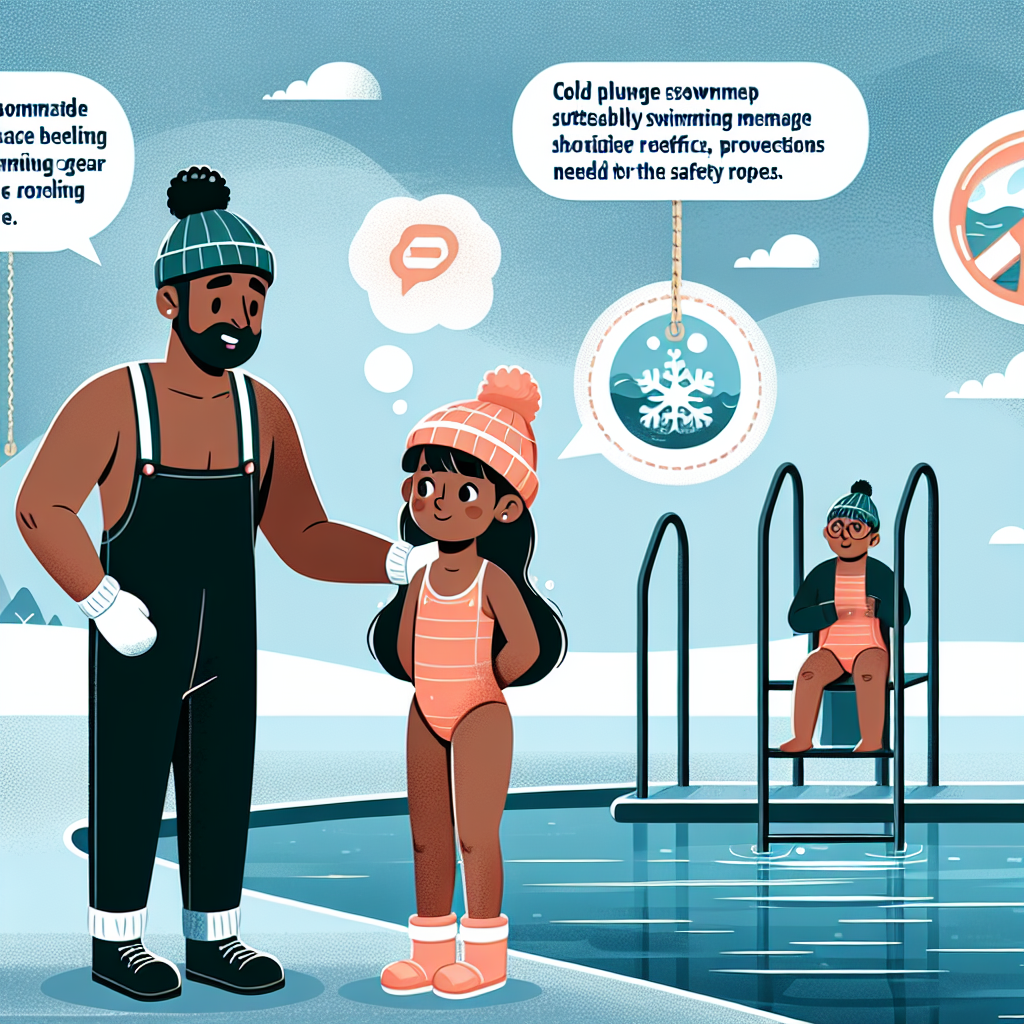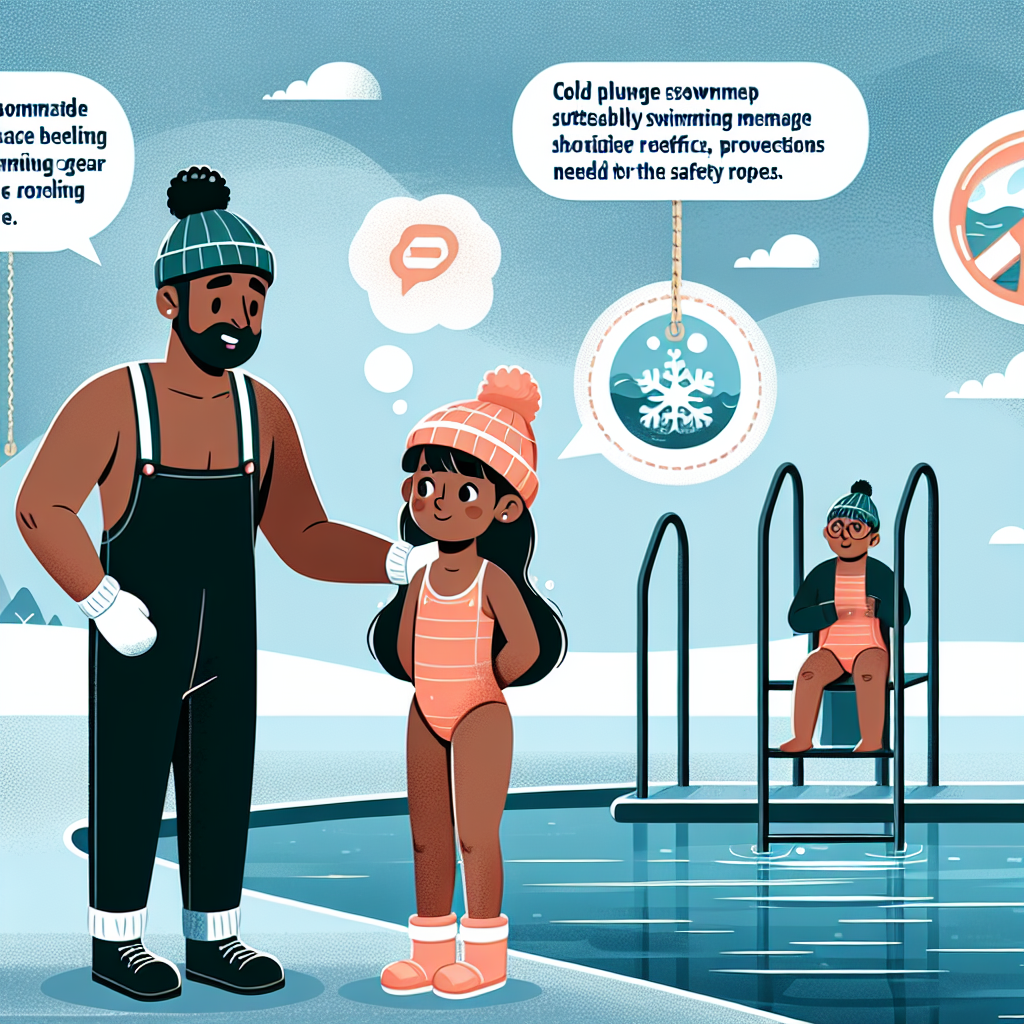Are you worried about your teen’s excitement to try cold plunge therapy and questioning its safety? In the article, “Cold Plunge Safety For Children And Teens: A Guide For Parents”, you’ll find everything you need to know about this new health and wellness trend. The guide simplifies the complexity of this topic, breaking it down to fundamental questions around safety measures, health benefits, potential risks, and preventative steps to take if your child or teen wants to participate in cold water immersion. This piece allows you to better understand cold plunging and its implications for young people’s health in a digestible, user-friendly manner.

Understanding Cold Plunge
Definition of Cold Plunge
Cold plunge, also known as cold water immersion, is a traditional practice that involves immersing the body into temperatures around 50-59 degrees Fahrenheit (10-15 degrees Celsius). This practice is not a new phenomenon, it has been a part of many cultures worldwide, from the Finnish sauna tradition to the plunge pools in Roman bathhouses.
Why Cold Plunge is gaining popularity
The cold plunge is currently gaining popularity due to the wide range of associated health benefits. Celebrities, athletes, wellness influencers, and everyday people alike are touting the rejuvenating benefits of taking a dip in icy waters. As more scientific studies are conducted, the health perks associated with cold plunging are further validated, continuing its trending ascent in the wellness world.
Benefits of Cold Plunge
Improves circulation and cardiovascular health
One of the key benefits you may gain with a cold plunge is improved circulation. By shocking the system with cold water, your body responds by rushing blood to your core to maintain body temperature. This reaction can strengthen your cardiovascular system over the long run.
Boosts immune system
Cold plunges may boost your immune system. By putting your body under controlled stress, cold water immersion can stimulate the immune response, helping to fend off illnesses and infections.
Enhances mental well-being
The practice of cold plunging can also enhance mental well-being. The shock of the cold can create a jolt of energy and increase endorphin levels, leading to mood enhancement. Many people find it an effective way to relieve stress and manage anxiety.
Reduces inflammation and muscle soreness
For athletes or anyone who engages in heavy physical activities, a cold plunge can help reduce muscle soreness and inflammation. This is why many sports professionals frequently use Ice baths as part of their recovery routine.
Promotes better sleep
Cold plunges can also improve the quality of your sleep by lowering your body temperature, further inducing relaxation and promoting a restful night’s sleep.
Risks and Considerations
Understanding the risks involved
Despite the numerous benefits, there are also some risks involved with cold plunges. It’s crucial to understand these risks before starting this practice. The immediate shock of cold can cause a gasp reflex, which could lead to water inhalation or hyperventilation if not careful.
Age appropriateness and physical readiness
With children and teens, it is important to consider their age and physical readiness for a cold plunge. The cold shock can be too extreme for younger children, and they may not respond to the stress as an adult would.
Medical conditions and contraindications
People with certain medical conditions, such as heart conditions, respiratory issues, or Raynaud’s disease, should avoid cold plunges unless permitted by their healthcare provider.
Supervision and safety measures
Make sure you never cold plunge alone, especially with children. Supervision is crucial to ensure safety and timely assistance in case of an emergency.

Safety Precautions for Children and Teens
Consulting with a healthcare professional
Before introducing your child to the cold plunge practice, consult with a healthcare professional. They will provide guidance and assessment based on your child’s health and physical readiness.
Gradually acclimating to cold water
One of the key safety measures is to gradually acclimate your child to cold water. Start with lukewarm water and slowly decrease the temperature over several sessions.
Supervision by a responsible adult
Children and teens should never cold plunge without adult supervision. A responsible adult present can respond quickly if they show signs of distress.
Avoiding prolonged exposure
Limit the exposure time to cold water, especially during initial sessions. Prolonged exposure can lead to hypothermia or frostbite.
Recognizing signs of distress or hypothermia
It’s crucial to be able to recognize signs of distress or hypothermia, such as shivering, skin turning blue, confusion, or difficulty speaking.
Preparing for a Cold Plunge Session
Selecting a suitable location
For a successful and safe cold plunge, it’s crucial to choose a suitable location. A plunge pool, cold bath, or a safe, natural body of water are good options.
Checking water temperature and quality
Always check the water temperature before starting a session. The water should be a safe cold temperature, typically around 50-59 degrees Fahrenheit. Also, cleanliness of water is crucial to prevent infection or illness.
Ensuring proper swimwear and gear
Everyone participating in cold plunge should don proper swimwear. For colder temperatures or natural bodies of water, you might also need additional gear like gloves, booties, or a swim cap to protect against hypothermia.
Educating children about safety procedures
Make sure children understand what to expect and how to respond to the shock of cold water. Teach them about safety procedures and explain the importance of communicating discomfort or distress.
Preparing for emergencies
Ensure access to warm blankets, heating devices, or a warm indoor area immediately upon exiting the water. Have a first aid kit handy and a phone ready for emergency calls.
Techniques for Cold Plunge
Cold showers
One of the easiest ways to introduce the practice of cold plunge at home is through cold showers. This can be done by gradually lowering the shower’s temperature over time.
Cold baths
A cold bath is another practical method. Fill up the bath with cold water and remain immersed for a certain amount of time.
Ice baths
If the body is prepared for colder temperatures, an ice bath might be an option. This involves filling a bathtub with water and ice and can provide more intense benefits.
Natural bodies of water
Natural bodies of water such as lakes, ponds, or ocean pools can also be used for cold plunge. However, these are season-dependent and need to ensure safety measures.
Cryotherapy chambers
A more modern method involves using cryotherapy chambers. These are controlled environments where temperatures are dropped drastically for a short period.
Supervision and Timing
Supervising children during a plunge
Supervising children or teens is crucial during their plunge. Always be ready to intervene in case of any discomfort or distress.
Determining duration of cold exposure
Start with short durations of Cold exposure and gradually increase it as the body becomes accustomed to the cold.
Gradually increasing plunge time
Each subsequent plunge session can last a little longer, but it’s important never to push the body further than it is comfortable.
Frequency of cold plunge sessions
Be regular but avoid plunging more than once or twice a day, as this could lead to undue stress on the body.
Alternatives to Cold Plunge
Cold towel therapy
If a full-body plunge seems too intense, a cold towel applied to the areas of the body can similarly increase circulation and reduce inflammation.
Cryotherapy facials
Cryotherapy facials are a focused way to enjoy the benefits of cold therapy. These treatments use jets of super-cooled air to boost skin health and reduce inflammation.
Cold water foot baths
To get started with cold exposure, you can begin by immersing your feet in cold water. This can help to prepare the body for future full-body immersions.
Cooling gels and creams
Another alternative is applying cooling gels and creams on the skin. These can simulate a cold plunge’s chilling effect and help soothe tired muscles and improve circulation.
Breathing exercises for thermoregulation
Breathing exercises, like those taught by Wim Hof, can help prepare and acclimatize the body for cold temperatures. Such exercises can also improve circulation and boost mood.
Encouraging Safe Behavior
Setting a good example
Always show safe behaviors when practicing cold plunge, especially around children. They will learn from your actions.
Creating a positive and supportive environment
Creating a positive and supportive environment will encourage safe practice and communication about discomfort or distress.
Offering incentives and rewards
Incentives and rewards can encourage children to gradually step out of their comfort zone and adapt to colder temperatures.
Monitoring progress and results
Keep a check on the progress of each family member. Note changes in their comfort level, endurance, and overall health.
Encouraging open communication
Encourage open discussion about their experience, discomfort, or fears associated with cold plunge. A supportive enough space will enable your child to communicate freely about any issues they might face.
Conclusion
The practice of cold plunge, while beneficial, requires the right approach, especially when involving children and teens. By taking all necessary precautionary measures, the whole family can safely enjoy its benefits. Remember to keep everything gradual, from introducing cold exposure to increasing plunge times; power through discomfort is not necessary or beneficial. The key is to make the practice enjoyable and safe for everyone.
